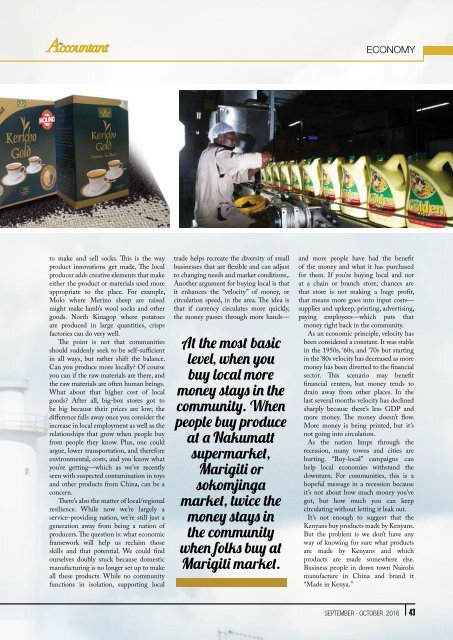The Accountant Sep-Oct-2016
You also want an ePaper? Increase the reach of your titles
YUMPU automatically turns print PDFs into web optimized ePapers that Google loves.
ECONOMY<br />
to make and sell socks. This is the way<br />
product innovations get made. <strong>The</strong> local<br />
producer adds creative elements that make<br />
either the product or materials used more<br />
appropriate to the place. For example,<br />
Molo where Merino sheep are raised<br />
might make lamb’s wool socks and other<br />
goods. North Kinagop where potatoes<br />
are produced in large quantities, crisps<br />
factories can do very well.<br />
<strong>The</strong> point is not that communities<br />
should suddenly seek to be self-sufficient<br />
in all ways, but rather shift the balance.<br />
Can you produce more locally? Of course<br />
you can if the raw materials are there, and<br />
the raw materials are often human beings.<br />
What about that higher cost of local<br />
goods? After all, big-box stores got to<br />
be big because their prices are low; the<br />
difference falls away once you consider the<br />
increase in local employment as well as the<br />
relationships that grow when people buy<br />
from people they know. Plus, one could<br />
argue, lower transportation, and therefore<br />
environmental, costs, and you know what<br />
you’re getting—which as we’ve recently<br />
seen with suspected contamination in toys<br />
and other products from China, can be a<br />
concern.<br />
<strong>The</strong>re’s also the matter of local/regional<br />
resilience. While now we’re largely a<br />
service-providing nation, we’re still just a<br />
generation away from being a nation of<br />
producers. <strong>The</strong> question is: what economic<br />
framework will help us reclaim those<br />
skills and that potential. We could find<br />
ourselves doubly stuck because domestic<br />
manufacturing is no longer set up to make<br />
all these products. While no community<br />
functions in isolation, supporting local<br />
trade helps recreate the diversity of small<br />
businesses that are flexible and can adjust<br />
to changing needs and market conditions,.<br />
Another argument for buying local is that<br />
it enhances the “velocity” of money, or<br />
circulation speed, in the area. <strong>The</strong> idea is<br />
that if currency circulates more quickly,<br />
the money passes through more hands—<br />
At the most basic<br />
level, when you<br />
buy local more<br />
money stays in the<br />
community. When<br />
people buy produce<br />
at a Nakumatt<br />
supermarket,<br />
Marigiti or<br />
sokomjinga<br />
market, twice the<br />
money stays in<br />
the community<br />
when folks buy at<br />
Marigiti market.<br />
and more people have had the benefit<br />
of the money and what it has purchased<br />
for them. If you’re buying local and not<br />
at a chain or branch store, chances are<br />
that store is not making a huge profit,<br />
that means more goes into input costs—<br />
supplies and upkeep, printing, advertising,<br />
paying employees—which puts that<br />
money right back in the community.<br />
As an economic principle, velocity has<br />
been considered a constant. It was stable<br />
in the 1950s, ‘60s, and ‘70s but starting<br />
in the ‘80s velocity has decreased as more<br />
money has been diverted to the financial<br />
sector. This scenario may benefit<br />
financial centers, but money tends to<br />
drain away from other places. In the<br />
last several months velocity has declined<br />
sharply because there’s less GDP and<br />
more money. <strong>The</strong> money doesn’t flow.<br />
More money is being printed, but it’s<br />
not going into circulation.<br />
As the nation limps through the<br />
recession, many towns and cities are<br />
hurting. “Buy-local” campaigns can<br />
help local economies withstand the<br />
downturn. For communities, this is a<br />
hopeful message in a recession because<br />
it’s not about how much money you’ve<br />
got, but how much you can keep<br />
circulating without letting it leak out.<br />
It’s not enough to suggest that the<br />
Kenyans buy products made by Kenyans.<br />
But the problem is we don’t have any<br />
way of knowing for sure what products<br />
are made by Kenyans and which<br />
products are made somewhere else.<br />
Business people in down town Nairobi<br />
manufacture in China and brand it<br />
“Made in Kenya.”<br />
SEPTEMBER - OCTOBER <strong>2016</strong> 43

















